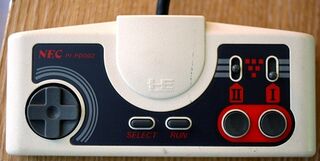Turbo Pad
From NEC Retro

| |||||||||||||||||||||||||||||||||||
| Turbo Pad | |||||||||||||||||||||||||||||||||||
|---|---|---|---|---|---|---|---|---|---|---|---|---|---|---|---|---|---|---|---|---|---|---|---|---|---|---|---|---|---|---|---|---|---|---|---|
| Made for: PC Engine, TurboGrafx-16 | |||||||||||||||||||||||||||||||||||
| Manufacturer: NEC Home Electronics | |||||||||||||||||||||||||||||||||||
| Type: Control pad | |||||||||||||||||||||||||||||||||||
|
The Turbo Pad (ターボパッド) was the standard-issue controller included in most versions of the PC Engine console. It is essentially identical to the original PC Engine Pad, but is equipped with two turbo switches placed above the main action buttons with up to three speed settings for each button.
The Turbo Pad was initially sold separately as a "premium" alternative to the standard Pad that came packaged with the original PC Engine console. But because the cost difference between the two controllers was pretty minimal for most consumers, the original Pad was quickly phased out as the Turbo Pad would be included with the subsequent models that were eventually introduced into the market, starting with the CofeGrafx and SuperGrafx, both released in the end of 1989 (the earlier Shuttle model instead came with the Turbo Pad II, which is functionally identical, but has a different form factor). The Turbo Pad has underwent numerous coloring and decal changes throughout the years, with each variant matching the design of the PC Engine model being sold at the time. Some variants of the Turbo Pad, such as the Duo version, were never sold separately and only came bundled with the corresponding console. The Duo-R would be the last model of the console that included a Turbo Pad, as the Duo-RX (which was consequently the last model of the console ever produced) came bundled with an Arcade Pad 6 controller instead.
Overseas, the Turbo Pad was standard-issue with the TurboGrafx-16 in North America, although this version of the controller uses a DIN 8 connector instead of the Mini DIN 8 used by the Japanese controllers. This type of connector would also be used for the European TurboGrafx and the Vistar in South Korea. The TurboDuo version of the controller, dubbed the Duo Pad, reverted back to using the same Mini DIN 8 connector as its PC Engine counterparts.
Contents
Gallery
Japan
- PCE LPD PAD.jpg
NEC LaserActive model (not sold separately)
United States
TurboGrafx-16 model (HES-PAD-01)
TurboDuo model (DUO-PAD-01)
- LaserActivePad US.jpg
Pioneer LaserActive model (CPD-N10)
Europe
TurboGrafx model
South Korea
Vistar model
Physical scans
| PC Engine, JP |
|---|
|
| PC Engine, JP (grey) |
|---|
|
| PC Engine, JP (black) |
|---|
|
| PC Engine, JP (white) |
|---|
|
References
| PC Engine |
|---|
| PC Engine (1987) | CoreGrafx (1989) | CoreGrafx II (1991) X1 Twin (1987) | PC-KD863G (1988) | Shuttle (1989) | GT (1990) | LT (1991) |
| Add-Ons |
| AV Booster (1988) | Interface Unit (1988) | Ten no Koe 2 (1989) | Backup Booster (1989) | Backup Booster II (1989) | Ten no Koe Bank (1991) | Memory Base 128 (1993) |












